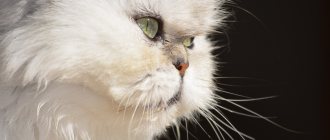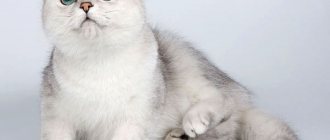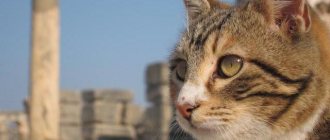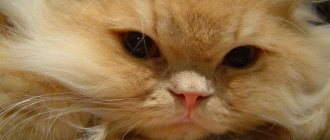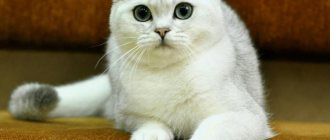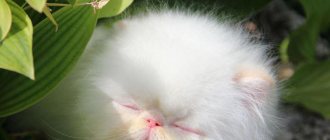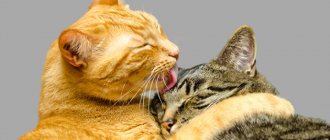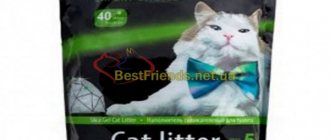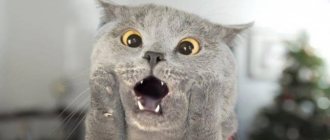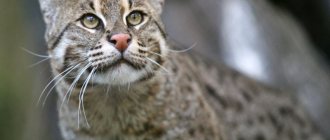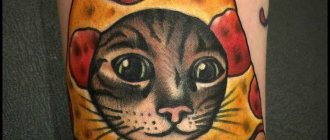The most popular long-haired breed is considered one of the oldest. Where the Persian cat comes from is not known for certain, although many are inclined to believe that its ancestors were the furry inhabitants of ancient Persia.
At first glance, she looks calm and obedient. On postcards and photographs you can see many fluffy cats in regal poses: “Persians” like to pose for the photographer.
History of the breed
The first cats of amazing beauty came to European countries, indeed, from Persia. More than four centuries ago, the Italian Pietro della Valle brought back fluffy beauties that looked like an angora from a trip to Asian countries. Judging by the descriptions, they had little in common with modern “Persians” - a wedge-shaped muzzle, a cut off forehead.
Felinologists believe that the long hair of Persian cats appeared as a result of a natural mutation, when the undercoat “swapped places” with the outer hairs. The breeders did the rest - they achieved the desired fur length, hair density, and developed a variety of colors.
There are suggestions that the distant ancestors of the modern Persian cat were the wild cat - the Pallas cat - and Asian cats. Over time, the appearance of the animal has undergone changes due to natural factors and selection work.
Interesting facts about the breed
The Persian cat breed differs from other breeds not only in appearance, but in the history of their development there are many interesting facts.
- Back in 1901, the first club of blue Persian cat lovers was created in Great Britain, where at first only blue-eyed specimens were recognized, but then yellow-eyed ones were also included in the standard.
- In the USA, since 1935, breeders began to breed long-haired Persian colorpoints. The first kitten with the nickname Debutant marked the beginning of the breed of cats with a Siamese pattern, but similar to the Persians.
- Persian cats were the favorites of Queen Victoria, who was inseparable from them. Following her, all the court ladies acquired blue Persians.
- Snow-white cats with blue eyes are often susceptible to a genetic disease. They are more likely to be deaf from birth.
- Chinchilla cats have a defect in the form of a short tongue, so they do not lick themselves.
- Persians are different from other cats in that they love grooming and take great pleasure in being brushed.
Of all the variety of amazing cat breeds that exist, many people around the world prefer the cute snub-nosed Persians.
General traits and standards of the Persian breed
The main characteristic of the breed is long and thick fur. The fur is thin but soft and can reach up to 15 centimeters in length. Externally, the Persian cat is distinguished by a beautiful lush “collar” on the shoulders and chest. The color can be monochromatic or multi-colored. In the first case, the color should be even throughout the entire body, in the second, the pattern should be clearly demarcated from the main one.
The body of the Persian cat is squat and massive. "Persians" are quite large animals with short, strong legs. On large, round feet, tufts of fur are visible between the toes.
The head of the Persian cat is round, located on a thick, short neck. On the muzzle are distinguished:
- prominent forehead;
- short wide nose.
Breed standards require that the tip of the nose does not protrude beyond the lower eyelid, and that the indentation at the transition from the nose to the forehead (saddle) is clearly visible. Supplement the description of the Persian cat:
- powerful chin;
- wide lower jaw;
- small but widely spaced ears with developed tufts of hair.
The eyes of Persian cats are large and expressive, with a characteristic shine that gives the face a pretty expression.
The weight of the animals reaches 3-7 kilograms, males are noticeably larger than cats.
Based on some features of appearance, several subtypes of the breed are distinguished:
- "Classic". The nose is slightly turned up, located slightly below the eye line.
- "Extreme" Has a small, flat nose, located at the level of the inner corners of the eyes.
- Shorthair exotic. The only difference is the length of the fur.
- Modern type. The nose is short, its edge coincides with the level of the lower eyelid. The eyes are round and expressive.
Types of Persians
Classic Persian cat (British)
The British subtype is today an outdated type of Persian, it is the most similar to the real original of the breed. Their nose is located just below the eyes and has a straight shape. Now such Persians are very rare.
Modern Persian (short nose)
In modern Persians, the upper edge of the nose is located almost at the same level with the eyelid, but the eyes are still large and protruding. This type is the most common and widespread today.
Extreme Persian (American look)
The extreme type has a higher nose than the modern Persian type, which is located almost level with the inner edge of the eyes.
Initially, small American-type Persians were born in the 20s of the twentieth century. It is with this appearance that the Persian cat is well known in America, and the more classic breed in Europe.
Peakfaces (too extreme character)
Not many cat lovers distinguish this type of Persian. But it still exists. This type of long-haired cat has a completely flat nose, and in addition it is located much higher than the corners of the eyes.
Peakface is prohibited by such a well-known organization as WCF. They are convinced that such a breed from the very beginning produces an incorrect balance of physical forms, which is harmful to the health of the animals.
See also photo of the Himalayan cat.
Features of character and behavior
“Persians” are pleasant to talk to, calm and easily tolerate limited space. By temperament, they could be called phlegmatic: cats will not jump on the curtains and drop vases from the table, however, they are not averse to running after a ball or hunting for a real mouse.
However, you should not imagine them as beautiful “dolls”. Despite the apparent docile nature, every Persian cat has a rather complex, capricious character. “Persians” are very smart, but they often use their extraordinary abilities to deceive their master. In reality, these animals are capricious and flattering.
Some habits of the “Persians” may seem strange, but for them it is quite natural:
- move the bowl of food towards you, rather than approaching it yourself;
- eat “from the claw”, without tilting your head towards the food;
- sleep on a cold balcony, giving up the usual bedding when a new family member appears in the house.
In a family, Persian cats choose “their” person and will be devoted to him all their lives. If a person responds with the same love to his pet, the relationship will go beyond the standard: the cat will be equated with family members.
Character traits inherent in the breed
According to the stories of owners of Persian pets, keeping a cat at home is a lot of fun. This is a playful representative of the cat family who loves his owner immensely. In addition, the breed has the following character traits:
- Persians have soft character traits and a very pleasant voice, which the cat practically never uses;
- the Persian constantly demands love and attention from his owners, repaying the same in return;
- the breed is gentle and pampered, although undemanding compared to other representatives of cats;
- the cat remains devoted to its owner until the end of its life, not forgetting to show its status.
Intrabreed varieties of Persian cats
Within a breed, animals differ in color.
Stand out:
- monochromatic cats;
- with partial coloring;
- colored within points;
- shaded;
- smoky tabby.
Black
A distinctive feature of the color is the complete absence of white and gray hairs and light undercoat. The eyes are copper or orange in color, the fur is long, especially in the collar area and on the chest.
The undercoat is thick. The pads are brown or black in color
White
The Persian cat, which has a snow-white coat, is characterized by:
- long, soft and smooth fur;
- eyes are blue, orange or multi-colored;
- short fluffy tail;
- pink nose and paw pads.
It is believed that white cats with blue eyes are deaf.
Blue
The blue Persian kitten initially has a tabby color, which later becomes invisible. Fur up to 10 cm long is soft and silky. The undercoat is thick. The paw pads, upturned nose and eyelids are grey-blue. The characteristic eye color is copper, the ears are small, and the fluffy tail is also small.
Cream
The eyes are copper or “orange” in color, the fur is unusually long, the eyelids, paw pads and nose are pink. Everything else is standard for the breed. The fur can have a creamy or brighter copper tint.
Red
The fur color is brighter than that of the cream Persian cat - orange-red. It can be plain or with “stains” characteristic of tabbies. To match the fur are the frames of the eyes, paw pads and nose, which has a characteristic upturned appearance. The eyes are also orange, an “orange” hue. With its muzzle the cat resembles a Pekingese.
Smoky
The smoky color of the Persian cat can have different tints:
- black;
- bluish;
- shade of chocolate;
- lilac;
- cream.
The main feature and advantage of this color variety is the silver-white undercoat. The fur is long, soft and silky. The paw pads, nose and eyelids of dark-colored cats are black, while those of light-colored cats are light, matching the coat.
The main wealth of smoky “Persians” is their characteristic fluffy tail, luxurious mustache and delightful shimmer of fur when moving.
Cameo
The unusual color of the Persian cat is characterized by a red or cream tint at the tips of the fur, while the whiteness of the undercoat becomes noticeable only when the fluffy beauty moves. The fur is distinguished by its length, the paw pads and small nose are pink. The eyes are copper or orange in color.
Color point
They were identified as a separate breed - the Himalayan: Persian cats with a Siamese color. The main “background” is white or ivory, the eyes are usually blue. The tail is distinguished by its splendor.
Chinchilla
The chinchilla has snow-white or golden fur, with shaded black or brown tips. The coat is lush, the fur is thick and long. The pads on the paws match the color of the fur, the eyes are green, “rimmed” with black.
Two-color
The bicolor Persian cat is distinguished by the presence of spots evenly distributed over a white background. According to breed standards, spots should not occupy more than 2/3 of the body, and white fur should not occupy more than ½. The color of the pads and nose matches the color of the spots. The eyes are “orange” color.
Tabby
The pattern can be seen on different colors:
- blue;
- lilac;
- chocolate;
- red;
- tortoiseshell;
- silvery
Match the color of the fur and paw pads, nose. Silver cats have green or brown eyes, while others have copper-colored eyes.
Tortoiseshell
“Persians” of tortoiseshell color have shaded or cameo fur, usually combining red, cream and black or blue, chocolate and lilac shades. The eyes are orange, the color of the nose matches the color of the coat.
Tortoiseshell with white
This variety is characterized by a combination of white fur with red, cream and black. Combinations of blue, lilac and chocolate shades are possible. Breed standards require white color on the face. The eyes are copper-colored, the nose matches the color of the coat, and the paw pads are multi-colored.
Tin (pewter)
The white coat has shaded black spots, usually on the paws and back. The nose and pads on the caps are brick-colored, the eyes are copper and have a black edging. A bushy tail and long whiskers are the pride of Persian Pewter cats.
Chocolate
Cats with chocolate-colored fur have orange eyes, pads, and a nose that matches their fur, which is evenly “dyed.” The presence of spots is uncharacteristic.
Lilac
The unusual color is complemented by “orange” eyes, a snub nose “to match” the fur and paw pads of the same color. The fur is thick, long, the tail is fluffy, and the ears are small.
Breed standard
The World Cat Federation has prescribed the following standard of appearance for Persian cats.
- The squat, large or medium-sized body is supported by low, stable paws. The chest and shoulders should be broad and muscular.
- The thick coat, up to 12 centimeters long, is fine and silky. The neck, shoulders and chest have a collar-shaped coat of fur.
- The not very long fluffy tail is slightly rounded at the end.
- The head is round and massive, of good proportions, with a voluminous skull.
- The forehead should be prominent and the cheeks should be full.
- Persians have a short and wide, slightly snub nose with very open nostrils.
- Strongly built jaws and chin.
- The ears are small, set wide and low on the skull. They should be rounded at the ends, with beautifully growing tufts of hair.
- The eyes are large, very expressive, shiny, round and spaced far apart. Their color depends on the specific coat color (they can be blue, golden and even multi-colored).
- The coat can be either one color or consist of two or three shades.
- The weight of the animals varies from 3 to 7 kg.
Features of care and maintenance, nutrition
Selection work has affected the character and behavior of the Persian cat. The main feature is the complete lack of survival skills in street conditions. An abandoned or lost animal is doomed to death.
But in a home environment, the cat feels like a queen. And as befits a true queen, she needs care. Long, thick fur requires care: daily combing, otherwise the fur will roll up and tangles will form. You will also have to put up with the fact that cat hair will appear everywhere in the house - “Persians” shed almost all year round.
In addition to the inconvenience for the owners, the animals themselves suffer from this: while licking themselves, they swallow a lot of hair, which can roll into a lump in the stomach and clog the gastrointestinal tract. It is necessary to give special medications that remove hair from the body painlessly. Many people give Persians a beautiful haircut.
Self-walking is not for Persian cats. If you walk it, do so only on a harness, so that the cat does not get plant debris or burdocks on its fur. After a walk, you need to comb it out immediately.
From early childhood, a kitten must be taught to bathe. If you wash your cat twice a month with special shampoos and conditioners, you can make brushing easier. Detergents should be chosen with medicinal herbs, and tinted shampoos are recommended for black cats. To prevent your pet's fur from becoming electrified, after it has dried, it must be treated with an antistatic spray.
The Persian cat's diet must contain the required amount of animal and plant proteins, amino acids and vitamins. The main condition is that industrially produced food must be chosen in a class not lower than premium, super-premium.
Features of caring for a pet
The Persian cat can be classified as one of the most demanding animals in terms of care. Due to the very long and thick coat, it is important to take good care of your pet every day. Otherwise, the wool rolls down and balls form. Every person who decides to have a Persian at home should have metal combs with teeth of different lengths, as well as brushes with different degrees of bristiness in their arsenal. You will also need a whole arsenal of cosmetics: shampoos, conditioners and, of course, talc.
In addition, the cat suffers from regular eye discharge and breathing problems, so it is important to clean the eyes from time to time . Having decided to have a fluffy Persian cat at home, it is important to be prepared to constantly care for the fur, bathe the animal, and also clean the eyes and ears. Only by giving care and love to an animal can you receive affection and devotion in return.
Health
Unfortunately, the “Persians” do not enjoy ideal health. They can have a whole bunch of genetic diseases. Due to the peculiar structure of the skull, the main problems of cats are the eyes and nose. Difficulty breathing may be due to an abnormal structure of the nasal septum.
This is especially noticeable in pain, stress, and in hot weather - the pet experiences shortness of breath and sounds similar to snoring are heard. This can affect the cat’s behavior - he is inactive and sleeps a lot. Surgery to widen the nasal septum may help, after which the animal will not experience a lack of oxygen.
Due to the shortened tear duct, Persians often experience lacrimation. If you don't take care of your eyes, discharge will accumulate in the corners and dry out. To help your cat, you need to regularly rinse your cat's eyes with warm water using a cotton swab.
The following serious diseases are much more severe in Persian cats:
- urolithiasis disease;
- renal failure;
- hypertrophic cardiomyopathy;
- viral rhinotracheitis;
- retinal atrophy.
The health of the “Persian” cannot be ignored. To increase your pet's lifespan, it is important to have regular checkups with your veterinarian.
Diseases of the Persian breed
Regular vaccinations and proper care are the key to excellent health for the Persians. The non-standard shape of the skull and nose can lead to breathing problems - animals can snore in their sleep. Tartar can often be observed in animals. Hereditary pathologies of “Persians” that require surgical intervention include:
- Polycystic kidney disease. It is found between the ages of 3 and 10 years.
- Retinal atrophy is progressive. Expressed in decreased quality of vision and blindness. In animals, during the development of the disease, the pupils of the pupils dilate significantly.
- Bladder stones. The pathology is typical for any age. If your cat frequently goes to the toilet and there is blood in the urine, you should immediately consult a veterinarian.
- Cystitis. The disease is manifested by frequent urination and changes in the color of urine. The animal has a tummy ache.
- Cardiomyopathy. Heart failure is characterized by shortness of breath, refusal to walk and other activities, and anorexia.
Persian cats may also have liver problems. Regular examinations - at least once every two to three months - will help prevent or promptly detect health problems in the animal.
Mr. Cat recommends: Table: pros and cons of the Persian cat breed
When deciding whether to take a Persian cat into your home, you need to compare all the pros and cons of the breed:
| pros | Minuses |
|
|
Character
For breed selection, along with a beautiful appearance, calm specimens were selected, which was subsequently reflected in the character of Persian cats. These cats have a gentle character, they are very affectionate and calm, which is why many people love them.
Persians can become upset if a person's attention is not paid to them. But as soon as you call your pet, he will immediately come running and rub himself at the owner’s feet. The peculiarity of the Persian cat’s character is that it cannot be offended for a long time and will not harbor anger or take revenge. Even dogs get along with Persians, so you can safely take a cat if you have another four-legged pet at home.
Persians are not very active; they can lie on the couch all day and sleep. Habits are expressed in laziness, so you don’t have to worry about ruined curtains or wallpaper, they will never do that.
The behavior of an animal is influenced primarily by the attitude of its owner towards it. The peculiarity of Persian kittens is that they are very attached to people and require a lot of attention, but if you want to take a little break from your pet, buy him a small ball, this breed loves to play with toys.
The behavior of Persians can be corrected; this breed is very smart and can be trained.
Purchasing a Persian kitten
“Persians” are extremely smart, so they have good habits from an early age; however, it is not recommended to buy a kitten younger than 3-4 months. By this age, they already know how to use a tray without fail and eat on their own. But the most important thing is that all vaccinations should be given by this time.
When choosing a kitten, it is important to pay attention to:
- kitten's ears - so that they are clean, without discharge;
- eyes - the presence of pus indicates the presence of infectious diseases;
- fur - shiny, soft - an indicator of health.
By purchasing a Persian cat, you can get a wonderful friend, a “sofa pillow” that prefers to curl up comfortably on the owner’s lap rather than create a “clatter of cats” in the apartment. The luxurious, well-groomed appearance of the “Persians” leaves no one indifferent: it is not for nothing that animals of this breed collect prizes at exhibitions and appear on postcards and photographs.
You can buy a Persian kitten without a pedigree and documents for 2-5 thousand rubles, a half-Persian - for 500-1000 rubles. Pedigree kittens in a nursery are much more expensive - the price can range from 7,000 to 20,000 rubles if the parents are titled.
Photo gallery of Persian cats:
